This is just a sample of the many
antique Salesman Samples & Patent Models we have sold.
Click link to see other
Sales Archive Pages on this Site.
We Buy Quality Antique Patent Models &
Salesman Samples
Contact Us at
AntiqBuyer@gmail.com
Special Note Concerning Prices Seen Below:
Most prices seen reflect actual sale results from this website.
Prices seen
span a long time and may not reflect current values. Some are selling
for more, many now sell for less.
On other pieces you will see no price, or a price range,
with or without an explanation. The reasons for that are discussed on the FAQ page.
Our current offering of Antiques for sale are at our sister Website Patented-Antiques.com.
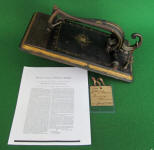 William
O. Grover 1863 Patent Model Sewing Machine The
patent for this early sewing machine was granted on January 27th 1863. The
patent number is 37502. It comes up with a Google search.
Looking at a copy of the patent we see that Baker was a witness.
Grover & Baker were a partnership famous for their line of "portable"
sewing machines which they first started producing in the 1850's.
Those are considered the first real portable sewing machine.
William
O. Grover 1863 Patent Model Sewing Machine The
patent for this early sewing machine was granted on January 27th 1863. The
patent number is 37502. It comes up with a Google search.
Looking at a copy of the patent we see that Baker was a witness.
Grover & Baker were a partnership famous for their line of "portable"
sewing machines which they first started producing in the 1850's.
Those are considered the first real portable sewing machine.This looks to be a sewing machine pulled off the assembly line with a modification or improvement over the prior design. In essence what Grover did here was simplify the earlier design by removing a second drive arm from below the table in order to simplify the mechanism and make it less likely to get out of adjustment. In the write-up he mentions Wheeler & Wilson having a patent for a one arm drive machine, but then differentiates his as needing fewer parts and thus being a better idea. Looks like the Patent Office agreed. It was the design used for most of their machines before dropping out of the competition / race sometime in the 1870's. It is a fine condition example and appears to be complete!! It is a fine condition example and appears to be complete!!
Fine . . . . . . . $1750.00 SOLD!!
 S.
B. Robinson 1854 Grain Drying Patent Model Mr. Robinson hailed from Oswego NY. The original tag is
missing, but it has the info on a piece of card stock attached to the side. The Patent # is 11140 Different and Nice!!.
S.
B. Robinson 1854 Grain Drying Patent Model Mr. Robinson hailed from Oswego NY. The original tag is
missing, but it has the info on a piece of card stock attached to the side. The Patent # is 11140 Different and Nice!!.
Good . . . . . $95.00 SOLD!!
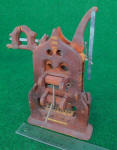 1872
Patent Model of Metal Forming Machine by H.
B. Sevey of Vienna Maine Mr. Sevey held a series of patents for similar machines having to do
with cutting forming, and upsetting metals. This model most
closely resembles his patent from 1872 for Improvement in Machines for Cutting, Punching, and Upsetting Metals. It has numerous
punches at the bottom, and at least three different size or type cutters incorporated into the design
as well as a vice and more. The original tag is missing, but
the Sevey name and Vienna Maine location are on a tag on the base.
Finding his patents with that info was simple. The patents
mention this being for use in making early tires. Different!!
1872
Patent Model of Metal Forming Machine by H.
B. Sevey of Vienna Maine Mr. Sevey held a series of patents for similar machines having to do
with cutting forming, and upsetting metals. This model most
closely resembles his patent from 1872 for Improvement in Machines for Cutting, Punching, and Upsetting Metals. It has numerous
punches at the bottom, and at least three different size or type cutters incorporated into the design
as well as a vice and more. The original tag is missing, but
the Sevey name and Vienna Maine location are on a tag on the base.
Finding his patents with that info was simple. The patents
mention this being for use in making early tires. Different!!
Good . . . . . $200.00 SOLD!!
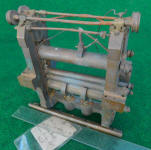 Ignatius
Hahn 1875 Patent Model of Roller Mill
Mr. Hahn was from Pittsburg PA. The original tag is present.
The patent # is 165819 and the patent comes up using Google. This
patent model is very heavy and made entirely of Brass. It has
many parts and there is some damage or missing pieces. Reading
the patent it seems this was for rolling out different metals at
very high pressures. Different!!
Ignatius
Hahn 1875 Patent Model of Roller Mill
Mr. Hahn was from Pittsburg PA. The original tag is present.
The patent # is 165819 and the patent comes up using Google. This
patent model is very heavy and made entirely of Brass. It has
many parts and there is some damage or missing pieces. Reading
the patent it seems this was for rolling out different metals at
very high pressures. Different!!
Good . . . . . $275.00 SOLD!!
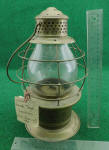 1879
Patent Model - Lantern by Joseph Trent Joseph
Trent of New York was granted 3 patents in numerical order for this lantern or
parts for it or others. 216540, 216541, and 216542. He assigned each
to the Manhattan Burner Co. a little known company in New York. It is not
known if it, or Mr. Trent were in any way associated with the Manhattan Brass
Co, another outfit with the same initials who were well known for their line of
different kerosene bike skaters, and railroad lamps.
1879
Patent Model - Lantern by Joseph Trent Joseph
Trent of New York was granted 3 patents in numerical order for this lantern or
parts for it or others. 216540, 216541, and 216542. He assigned each
to the Manhattan Burner Co. a little known company in New York. It is not
known if it, or Mr. Trent were in any way associated with the Manhattan Brass
Co, another outfit with the same initials who were well known for their line of
different kerosene bike skaters, and railroad lamps. In the patent description Mr. Trent describes different aspects of his lantern and how it works. The perforations served a couple functions. He also mentions a wire screen inside the font. It also features a locking mechanism and a special set up to allow raising the wick without going inside, raising, or tipping the outer glass globe. He mentions its different attributes as being especially well suited for railroad lanterns. It is in overall nice cosmetic condition, noting a sprial crack in the outer globe. It comes from the base and curves up to about halfway and then ends. It is solid - for now.
An interesting piece of Americana lighting history and Railroad memorabilia that will make for a good addition to many collections.
Good + . . . . . $1795.00 SOLD!!
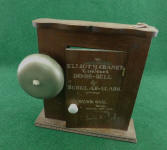 1866
Patent Model - Combined Doorbell / Burglar Alarm by E. H. Crane This
combined Door Bell - Burglar Alarm is in very nice original condition and
comes with its
original tags. Mr. Elliot Crane hailed from St. Joseph County MI and was an
embalmer taxidermist there. He gets a long mention in a recently published
book on the area titled Hidden History of St. Joseph County, Michigan by Kelly Pucci. He also held a patent for an embalming / taxidermy process where you did not
have to remove the flesh.
1866
Patent Model - Combined Doorbell / Burglar Alarm by E. H. Crane This
combined Door Bell - Burglar Alarm is in very nice original condition and
comes with its
original tags. Mr. Elliot Crane hailed from St. Joseph County MI and was an
embalmer taxidermist there. He gets a long mention in a recently published
book on the area titled Hidden History of St. Joseph County, Michigan by Kelly Pucci. He also held a patent for an embalming / taxidermy process where you did not
have to remove the flesh. The idea here was that after mounting the spring loaded bell on the jamb next to the door, you would lift the spring loaded lever up to "lock" the door and set the bell or alarm. Pushing the door open would release the lever and set it off the alarm ringing the bell. Simple efficient, and worthy of patent # 55823 granted in 1866. It is a good number, and the patent comes right up with a Google search.
A neat piece of Americana that will be a good addition to many collections.
Fine . . . . . $695.00 SOLD!!
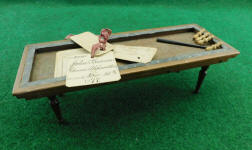 1877
Patent Model - Game Apparatus by John Brown This
game has aspects that combine ideas from several different games
including Billiards, Pool and Bagatelle. The patent calls for multi
sided pins, the use of balls, a "cue
stick" and the billiard or pool like cushioned table.
There
is a brass tag inset into the table top with the inventors name and Providence
RI location. It has its original tags and red ribbon as well. The
patent # is 197,091, and the patent comes up with a Google search.
1877
Patent Model - Game Apparatus by John Brown This
game has aspects that combine ideas from several different games
including Billiards, Pool and Bagatelle. The patent calls for multi
sided pins, the use of balls, a "cue
stick" and the billiard or pool like cushioned table.
There
is a brass tag inset into the table top with the inventors name and Providence
RI location. It has its original tags and red ribbon as well. The
patent # is 197,091, and the patent comes up with a Google search. An interesting note is that there is another version of this patent model in the Cooper-Hewitt Museum in New York. That example is referred to as "improved". I also found reference to that model in a book titled American Enterprise: Nineteenth-Century Patent Models. New York by Post, Robert E.
The patent description explains that the game is similar to billiards, but easier to play, and less expensive. A game for the masses. A neat piece of Americana and gaming history that will be a good addition to many collections.
Good . . . . . $595.00 SOLD!!
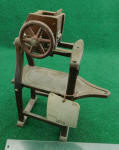 1879
Patent Model - Cider Mill by E. Barton Edmund Barton of Philadelphia PA and was granted patent # 217,976 for his Apple Cider
Mill idea in 1879. The number is good, and the patent is easily viewable
with Google. This model is in nice condition, and has its original
tags.
1879
Patent Model - Cider Mill by E. Barton Edmund Barton of Philadelphia PA and was granted patent # 217,976 for his Apple Cider
Mill idea in 1879. The number is good, and the patent is easily viewable
with Google. This model is in nice condition, and has its original
tags.The design is a simple straight forward plan for what to do with all the extra apples after the pies have been made, and the others good apples or other fruit were peeled, cored and put up for storage and later use. The inventors claim is that this design, a round drum with straight lines of pins to grind the apples down to "pumice" will not clog, need plunging, or other things that other inferior designs required when making cider.
An interesting piece of Americana and early farming history. Apples and apple processing equipment like peelers, corers and slicers hold a special interest with kitchen antique and APES a select group of dedicated collectors of all things apple. The club they formed is called APES, and Apple related tools are such a popular collectible that entire books have been published on the subject. A good nice addition to many collections.
Fine . . . . . $795.00 SOLD!!
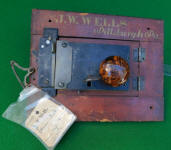 1858
Patent Model Door Alarm Lock by Jonathan Wells
Jonathan Wells of Pittsburg PA was granted a patent for his novel door alarm idea on
September 7 1856. The number is 21457. It is a close match to
the drawing submitted with the model and comes up with a Google search. It measures approx. 13
across by 10" tall. The model has the key and the lock does operate. The idea is that once locked, attempting to unlock
the door would initiate a series of events , a spring loaded gizmo would be
activated, and would move
the pieces seen outside the lock, which in turn would ring the external bell.
The patent states that the bell could be placed in any location, and so one
was not shown in the patent or included w/ the model. It appears to
operate as intended noting the lack of one attaching wire to the outside
swinging arm seen. Interesting!!
1858
Patent Model Door Alarm Lock by Jonathan Wells
Jonathan Wells of Pittsburg PA was granted a patent for his novel door alarm idea on
September 7 1856. The number is 21457. It is a close match to
the drawing submitted with the model and comes up with a Google search. It measures approx. 13
across by 10" tall. The model has the key and the lock does operate. The idea is that once locked, attempting to unlock
the door would initiate a series of events , a spring loaded gizmo would be
activated, and would move
the pieces seen outside the lock, which in turn would ring the external bell.
The patent states that the bell could be placed in any location, and so one
was not shown in the patent or included w/ the model. It appears to
operate as intended noting the lack of one attaching wire to the outside
swinging arm seen. Interesting!! Very Good . . . . . . $500.00 SOLD!!
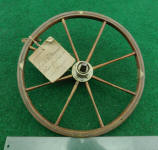 1881 Patent Model - Wheel for Vehicles by Soule & Manuel John
Soule and David Manuel of Hyde Park Mass were granted patent # 241,244 for their
buggy or wagon wheel idea in 1881. It is a good number and closely matches
the patent. Cutting edge technology for the time no doubt. The
patent describes the outer rim being constructed of wood with a layer of
rubber or elastic material sandwiched between layers, so constructed so that the spokes did something, but
not sure what. Te spokes are set at an angle that is mentioned, but not
well explained. It also goes on to describe the roller type bearings in the
hub. That aspect works well, but can only be seen in the drawings.
1881 Patent Model - Wheel for Vehicles by Soule & Manuel John
Soule and David Manuel of Hyde Park Mass were granted patent # 241,244 for their
buggy or wagon wheel idea in 1881. It is a good number and closely matches
the patent. Cutting edge technology for the time no doubt. The
patent describes the outer rim being constructed of wood with a layer of
rubber or elastic material sandwiched between layers, so constructed so that the spokes did something, but
not sure what. Te spokes are set at an angle that is mentioned, but not
well explained. It also goes on to describe the roller type bearings in the
hub. That aspect works well, but can only be seen in the drawings.An interesting piece of Americana and early transportation history.
Fine . . . . . $795.00 SOLD!!
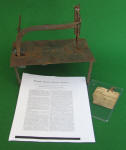
Good . . . . . . . $1600.00 SOLD!!
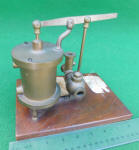 1869
Patent Model Boiler Feeder by T. B. Webster
T. B. Webster was granted a US patent for his "Automatic Boiler Feeder" on
March 23 1869. The number is 88246. It is a close match to
the drawing submitted with the model and comes up with a Google search if
you ad an A. The tags are quite faded, but with a bit of help from
Google I was able to pull up the patent.
1869
Patent Model Boiler Feeder by T. B. Webster
T. B. Webster was granted a US patent for his "Automatic Boiler Feeder" on
March 23 1869. The number is 88246. It is a close match to
the drawing submitted with the model and comes up with a Google search if
you ad an A. The tags are quite faded, but with a bit of help from
Google I was able to pull up the patent.The model is mounted to a wooden board and measures approx. 8" square. The model is constructed almost entirely of brass. It is brass cylinder with a lever operated check valve to control the flow of water into the boiler. The patent claims that this arrangement will take care of most issues involved in both the ins and outs of the water to the boiler. Problems solved. Interesting & Nice!!
Very Good . . . . . . $150.00 SOLD!!
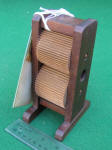 Original USPO Patent Model Fluting Rollers by Thomas Robjohn of New York
This wooden inventor's model was the original model submitted to the US
patent office that accompanied the application requesting a patent. It
stands just 7" tall x 3" across x 2" deep. The
tag says the patent # is 149,526 and that the patent was granted Apr. 7,
1874. Thomas Robjohn held several patents
for different designs of fluting machines, but I could not seem to make this
patent come up looking for it on Google. He also held a patent for an
inkwell. I did find a similar patent under a reissue # that was assigned to
his wife. In that patent it said he was now deceased. It was a
very long and detailed patent description laying out a series of claims.
Patent models are historically significant one-of-a kind antiques!!
Original USPO Patent Model Fluting Rollers by Thomas Robjohn of New York
This wooden inventor's model was the original model submitted to the US
patent office that accompanied the application requesting a patent. It
stands just 7" tall x 3" across x 2" deep. The
tag says the patent # is 149,526 and that the patent was granted Apr. 7,
1874. Thomas Robjohn held several patents
for different designs of fluting machines, but I could not seem to make this
patent come up looking for it on Google. He also held a patent for an
inkwell. I did find a similar patent under a reissue # that was assigned to
his wife. In that patent it said he was now deceased. It was a
very long and detailed patent description laying out a series of claims.
Patent models are historically significant one-of-a kind antiques!! Very Good . . . . . . $595.00 SOLD!!
 1876
Patent Model Signal Lantern by H. H. Doty
H. H. Doty a citizen of England and resident of London was granted a US patent for this signal lantern on June 13th 1876. The number is
18607. It is a close match to
the drawing submitted with the model and comes up with a Google search.
The opening sentence of the patent calls for it to be used for railroads,
marine applications like lighthouses, or other. Numerous references of
the patent come up with an internet search and it being related to
lighthouses.
1876
Patent Model Signal Lantern by H. H. Doty
H. H. Doty a citizen of England and resident of London was granted a US patent for this signal lantern on June 13th 1876. The number is
18607. It is a close match to
the drawing submitted with the model and comes up with a Google search.
The opening sentence of the patent calls for it to be used for railroads,
marine applications like lighthouses, or other. Numerous references of
the patent come up with an internet search and it being related to
lighthouses. The model measures approx. 2 1/2" dia. by 10" tall. It is constructed almost entirely of brass. It is marked in two places with the Doty name. Interesting, Historic & Nice!!
Very Good . . . . . . $1150.00 SOLD!!
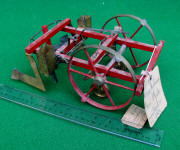 1878
Patent Model of Corn Planter by Adam Heckman The
patent for this corn planter was granted to Adam Heckman on April 30th 1878.
The patent number is 203149. It is viewable on Google. Adam
Heckman hailed from Sterling Illinois which is west of Chicago and in the
heart of corn country.
1878
Patent Model of Corn Planter by Adam Heckman The
patent for this corn planter was granted to Adam Heckman on April 30th 1878.
The patent number is 203149. It is viewable on Google. Adam
Heckman hailed from Sterling Illinois which is west of Chicago and in the
heart of corn country.The patent covers a number of different aspects in the design of improvements for a corn planter. Heckman describes each aspect in some detail in his patent application. The planter has two sets of wheels, one for use when operating the planter, and a second set that would come into play when it was simply being moved. It has two brass seed boxes and the patent describes these, the drop / feed tubes and how they operate. The model has just one of those drop tubes. It goes on to describe the seat, (note loose solder joints,) and the how, why, and when that the second set of wheels would come into play. It also has a feature to cover the seed with dirt after the seed has been dropped in the furrow. There is also a scraper feature that would keep the wheels free of dirt build-up as well.
The overall condition is nice noting some minor missing pieces. One being a plow cutter that is a simple piece of folded galvanized sheet material that would be an easy fix. Very unusual!!
Very Good . . . . . . $750.00 SOLD!!
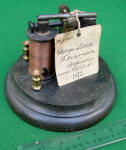 George
Little 1873 Patent Model of Telegraph Apparatus
The model is mounted on a round
cast iron base has its original tag and ribbon. The overall condition
is nice. George Little was granted a patent for this Telegraph Apparatus on
September 2 1873.
The patent number is 142486. It is viewable on Google and is a close
match. George Little hailed from Rutherford Park NJ and was a contemporary and
competitor to Edison, Western Union and others in the early telegraphy
field.
George
Little 1873 Patent Model of Telegraph Apparatus
The model is mounted on a round
cast iron base has its original tag and ribbon. The overall condition
is nice. George Little was granted a patent for this Telegraph Apparatus on
September 2 1873.
The patent number is 142486. It is viewable on Google and is a close
match. George Little hailed from Rutherford Park NJ and was a contemporary and
competitor to Edison, Western Union and others in the early telegraphy
field.George Little was a well known figure in the development of telegraphy. He was issued his first patent back in the 1840's during the infancy of the telegraphic revolution. Google searches turn up reams of info on him and his endeavors. He held several other earlier telegraphy related patents that are mentioned in the patent for this device as well. He also held a patent for a electro magnetic motor. Several references noted that Thomas Edison claimed he could improve on Little's original invention and worked on it.
The patent describes how this design will improve transmission rates and alleviate the problem of the signal becoming garbled or running together in rapid transmissions. George little describes how this is accomplished in some detail that makes little sense to a novice but it was novel or important enough to be granted a patent. A passage found on the internet mentions that Daniel Craig founder of the American Rapid Telegraph Co. in 1879 touted Little's patented telegraph invention as making it possible to send 100 word letters out for a dime, and that later they would charge by the yard. The company went bankrupt in 1884.
An interesting, important & unusual piece of telegraphy and early communication technology!! Opportunity!!
Very Good . . . . . . $1695.00 SOLD!!
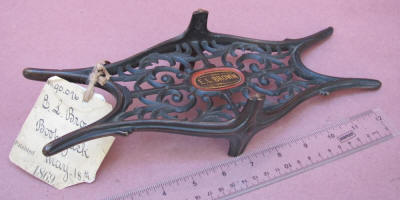 E.
L. Brown 1869 Double End Patent Model
Boot Jack Mr. Edwin Lee Brown of Chicago ILL got the patent for his interesting
style bootjack May 18th 1869.
The patent # is 90076 and the model is very similar to those found that were
produced. There are a couple of variations listed for sale on the
other pages. Not only does e the paten call for this to be a double ender,
it also claims that it is reversible, or can be used when flipped. His
claim was something along the lines of always ready and never out of
adjustment. It is constructed of brass, and the condition is super. This
bootjack has a great look and presence. It will be a key piece in any bootjack
or early Americana collection. As nice as they come!! Recommended!
E.
L. Brown 1869 Double End Patent Model
Boot Jack Mr. Edwin Lee Brown of Chicago ILL got the patent for his interesting
style bootjack May 18th 1869.
The patent # is 90076 and the model is very similar to those found that were
produced. There are a couple of variations listed for sale on the
other pages. Not only does e the paten call for this to be a double ender,
it also claims that it is reversible, or can be used when flipped. His
claim was something along the lines of always ready and never out of
adjustment. It is constructed of brass, and the condition is super. This
bootjack has a great look and presence. It will be a key piece in any bootjack
or early Americana collection. As nice as they come!! Recommended! Fine . . . . . .$995.00 SOLD!!
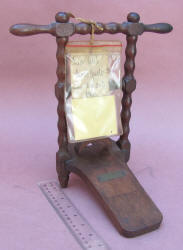 1858
Patent Model
Boot Jack This interesting valet style bootjack was patented
December 28th 1858 by Fred Ahl of West Meriden CT. The patent # is
22404. Fred covered all the bases here, and claimed that this could
also double as a hat rack, or clothes stand. He called the swinging
arm a vibrator, and went on to describe how you could dismantle it should
you want to take it with you on your next outing or trip. This
bootjack has a great look and presence. It will be a key piece in any
bootjack or early Americana collection. As nice as they come!!
Recommended!
1858
Patent Model
Boot Jack This interesting valet style bootjack was patented
December 28th 1858 by Fred Ahl of West Meriden CT. The patent # is
22404. Fred covered all the bases here, and claimed that this could
also double as a hat rack, or clothes stand. He called the swinging
arm a vibrator, and went on to describe how you could dismantle it should
you want to take it with you on your next outing or trip. This
bootjack has a great look and presence. It will be a key piece in any
bootjack or early Americana collection. As nice as they come!!
Recommended! Fine . . . . . .$795.00 SOLD
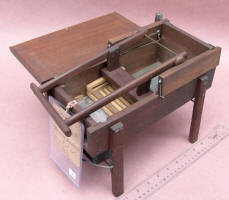 1873
Washing Machine Patent Model by J. Bennett
This washing machine patent model has its original tag. The patent was issued on
October 21st 1873 with the patent # of 143869. This patent model is
approx 10" Long x 8"
or so wide at the widest point with the top / table folded out. The model is a good match to the patent
drawing which can be viewed
using Google Patents search with the number 143869.
1873
Washing Machine Patent Model by J. Bennett
This washing machine patent model has its original tag. The patent was issued on
October 21st 1873 with the patent # of 143869. This patent model is
approx 10" Long x 8"
or so wide at the widest point with the top / table folded out. The model is a good match to the patent
drawing which can be viewed
using Google Patents search with the number 143869.This is one of those patent models that is over designed. To use the first step would be to fire up the boiler built into the base. The entire bottom is a metal firebox that acts as the heat exchanger to warm up the water. The exhaust stack can be seen rising from the rear corner. Next the user would have to assemble the parts that are by design stored inside. The patent claims this as a benefit to keep the user from splashing suds and water around. In the bottom is a roller affair that the upper arm with its "rubber" face works against. First though you have to get this arm correctly positioned into the guides that were attached to the sides you had previously attached. It took me about 10 minutes to figure this all out before I had to go to the instructions. This is one of the more complicated washer models I have ever had, and the first with a provision to be heated with a fire underneath. Neat and Different!!
The condition is excellent!!
Excellent. . . . . .$995.00 SOLD
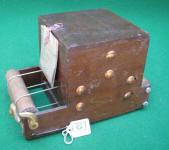 1874
Patent Model of Cloth Sponging Machine James
Dammerall of Boston Mass was granted a patent for his cloth sponging machine
on February 10th 1874. The patent number is 147243. This model came from the Mr. & Mrs. O. Rundell
Gilbert collection and has those tags as well as the original Patent Office
tag.
1874
Patent Model of Cloth Sponging Machine James
Dammerall of Boston Mass was granted a patent for his cloth sponging machine
on February 10th 1874. The patent number is 147243. This model came from the Mr. & Mrs. O. Rundell
Gilbert collection and has those tags as well as the original Patent Office
tag.The idea here is still used today to treat or size fabric. It seems freshly made fabric must be "sponged" as part of the process to keep it from shrinking later on. Basically it is run through a machine with a series of rollers, steam is introduced into the closed chamber, and after being stretched and pulled and rolled around for a while the cloth will come out the other side a finished product. The box is Mahogany and in nice overall condition. The basic form is close to the patent drawing noting that there are no feet or a base as is shown in the dawing. Different!!
Good . . . . . . $295.00 SOLD!!
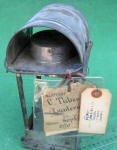 1870
Patent Model of Lantern by C. Tabor
This interesting and nice looking patent model lantern has its original tag
and ribbon. It also has a tag from the seller O. Rundle Gilbert who was
one of the owners of the collection after the government sold them all off back
in the 20's.
1870
Patent Model of Lantern by C. Tabor
This interesting and nice looking patent model lantern has its original tag
and ribbon. It also has a tag from the seller O. Rundle Gilbert who was
one of the owners of the collection after the government sold them all off back
in the 20's. This patent model is approx 4 1/2 " wide x 10" tall. It is a good match to the patent which can be viewed using Google Patent Search. It includes features like the clutch / disconnect for the wick adjuster, and for the different design burner. Nice!!
Excellent. . . . . .$395.00 SOLD!
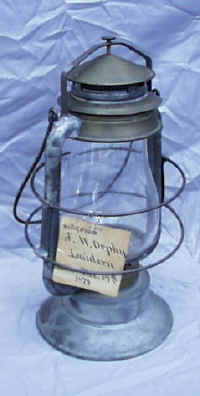 1878
Patent Model of Lantern by J. W. Orphy This
is a very important patent model in the development of Barn Lanterns.
Mr. Orphy, who was the inventor, assigned this idea to the well known
maker of lanterns C. T. Ham and F. D. Clarke of Rochester New York back
in 1878. Mr. Orphy also had a least two other patents for lanterns
or parts for them that I have been able to find information about.
The ideas for this lantern revolve around the tubes running up the sides
that will provide air for combustion and not be affected by the wind or
by the lantern being swung about in use and blowing out or making the
flame flicker.
A problem that was being addressed by several other makers and inventors
of lanterns during this period as well. There are a lot of lanterns out
and about, and not being an expert about them, I do not know if this was his idea
alone, or whether other folks were using the same basic ideas before this or
not, or where this idea fits into the scope chronologically in the
development of this idea. The first person I showed this too said the
patent was most likely for the screw top and that being the means to
hold the globe in place, but in the papers, Mr. Orphy barely mentions
that and instead talks about air getting to the burner and the tubes and
so forth. Makes little difference, it still looks great, the
condition is super and patent models of anything interesting,
significant or graphic are getting harder and harder to find.
1878
Patent Model of Lantern by J. W. Orphy This
is a very important patent model in the development of Barn Lanterns.
Mr. Orphy, who was the inventor, assigned this idea to the well known
maker of lanterns C. T. Ham and F. D. Clarke of Rochester New York back
in 1878. Mr. Orphy also had a least two other patents for lanterns
or parts for them that I have been able to find information about.
The ideas for this lantern revolve around the tubes running up the sides
that will provide air for combustion and not be affected by the wind or
by the lantern being swung about in use and blowing out or making the
flame flicker.
A problem that was being addressed by several other makers and inventors
of lanterns during this period as well. There are a lot of lanterns out
and about, and not being an expert about them, I do not know if this was his idea
alone, or whether other folks were using the same basic ideas before this or
not, or where this idea fits into the scope chronologically in the
development of this idea. The first person I showed this too said the
patent was most likely for the screw top and that being the means to
hold the globe in place, but in the papers, Mr. Orphy barely mentions
that and instead talks about air getting to the burner and the tubes and
so forth. Makes little difference, it still looks great, the
condition is super and patent models of anything interesting,
significant or graphic are getting harder and harder to find.
Good . . . . .$2495.00 SOLD
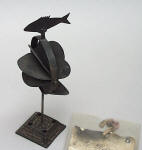 1875 Patent Model of Weathervane / Chimney Top
/ Deflector Here is a great example of a
wonderful and graphic design that comes in a small package. This
dated and tagged Patent Model is from 1875, and only stands about 6"
tall to the top of the flat bodied fish weathervane portion. The
inventors name was Munger, and the patent # is 159,344. The idea
was the the prevailing wind would spin this around so that it's tail
would faced the wind, and then the spinning vanes would draw the smoke
up and out of the chimney, with the small shield at the bottom keeping
rain or snow from entering. It would also have the effect of
rotating and protecting the chimney top away from strong winds that in
some instances can or would create downdrafts that would smoke up the
house. It is interesting to note that this style of chimney top is
still in use today and marketed to folks who live along the coast of
Oregon and Ca to help with the strong winds and driving rains that can
occur there. I can remember seeing them on roofs and marveling at
what a neat idea this was, and then a couple years ago I found this
model and recognized it as being very similar in design and function.
No new ideas!! The overall condition is OK, noting that the
top of the tag has what appears to be some fire / burn damage. The
base of the model also appears to be a replacement and was paper holder,
but it looks proper and feels great to the overall effect. A
nice display piece that has a great look.
1875 Patent Model of Weathervane / Chimney Top
/ Deflector Here is a great example of a
wonderful and graphic design that comes in a small package. This
dated and tagged Patent Model is from 1875, and only stands about 6"
tall to the top of the flat bodied fish weathervane portion. The
inventors name was Munger, and the patent # is 159,344. The idea
was the the prevailing wind would spin this around so that it's tail
would faced the wind, and then the spinning vanes would draw the smoke
up and out of the chimney, with the small shield at the bottom keeping
rain or snow from entering. It would also have the effect of
rotating and protecting the chimney top away from strong winds that in
some instances can or would create downdrafts that would smoke up the
house. It is interesting to note that this style of chimney top is
still in use today and marketed to folks who live along the coast of
Oregon and Ca to help with the strong winds and driving rains that can
occur there. I can remember seeing them on roofs and marveling at
what a neat idea this was, and then a couple years ago I found this
model and recognized it as being very similar in design and function.
No new ideas!! The overall condition is OK, noting that the
top of the tag has what appears to be some fire / burn damage. The
base of the model also appears to be a replacement and was paper holder,
but it looks proper and feels great to the overall effect. A
nice display piece that has a great look.
Good . . . . . $795.00 SOLD
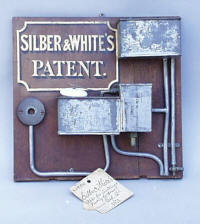 1871
Silber & White Patent Model of Light fixture / Heater and Delivery
System This is an interesting patent model
depicting a series of fuel storage tanks, a float, shutoff valves and more to control
the flow of a given liquid fuel to the round fixture holder at the left which
could be a light, heater or whatever else was consuming the fuel.
This model was made to represent different floors of a house, building
or
factory, etc. The inventors were both from England, and bought
their novel and cutting edge technology to the US Patent office to
obtain a patent here in 1871 least anybody else try and steal their idea. The top tank is the major reservoir, which was to be located
outside the building or on the roof or other convenient place. The
second tank is referred to as the filtering tank and would distribute
the fuel to all the other fixtures found at that level. The tank
with the white porcelain float valve is one of the main factors for the
patent in that it senses the demand and will either allow fuel to be
constantly fed to the burner, or when the burner is turned off and the
float rises to it top position it will cause the flow of fuel to stop,
thus eliminating overflows. It is very graphic, measures approx
12x12" the limit allowed by the patent office, and has a great look.
The condition
is super and patent models of anything interesting, significant or
graphic are getting harder and harder to find. This is a good
one and will display nicely as it is flat and can be hung on the wall
behind the desk as a reminder of just how far we have come!!
1871
Silber & White Patent Model of Light fixture / Heater and Delivery
System This is an interesting patent model
depicting a series of fuel storage tanks, a float, shutoff valves and more to control
the flow of a given liquid fuel to the round fixture holder at the left which
could be a light, heater or whatever else was consuming the fuel.
This model was made to represent different floors of a house, building
or
factory, etc. The inventors were both from England, and bought
their novel and cutting edge technology to the US Patent office to
obtain a patent here in 1871 least anybody else try and steal their idea. The top tank is the major reservoir, which was to be located
outside the building or on the roof or other convenient place. The
second tank is referred to as the filtering tank and would distribute
the fuel to all the other fixtures found at that level. The tank
with the white porcelain float valve is one of the main factors for the
patent in that it senses the demand and will either allow fuel to be
constantly fed to the burner, or when the burner is turned off and the
float rises to it top position it will cause the flow of fuel to stop,
thus eliminating overflows. It is very graphic, measures approx
12x12" the limit allowed by the patent office, and has a great look.
The condition
is super and patent models of anything interesting, significant or
graphic are getting harder and harder to find. This is a good
one and will display nicely as it is flat and can be hung on the wall
behind the desk as a reminder of just how far we have come!!
Good . . . . .$795.00 SOLD
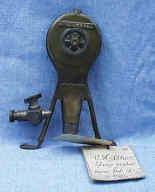 1881
Patent Model of Water / Steam Motor This
Patent Model came out of an old time collection here in California. It is unusual in that you have to read and study the papers that
came with it to fully understand and appreciate exactly what it is.
Typically, Patent Models have their primary feature or the patented idea clearly
visible to the eye so that you could see and get a sense of what you were giving
/ getting a patent for. This is a very detailed and well made brass model, and has a
water wheel / motor inside, but Mr. Atwell did not do a cutaway, or allow any
visual means of seeing what was going on inside his water motor's outside brass
housing. And there is no provision for taking it apart to inspect the innards.
Basically his idea was that you could increase the power and efficiency of a
pretty standard design water motor by installing and utilizing an auxiliary port
through which you fed additional streams of steam or gas in addition to the main
jet of water. As with most patent descriptions this one is very wordy and
extremely detailed, to the point of being confusing, but it seems to have been
enough to impress the proper government officials as Mr. Atwater was granted
his patent in 1881. This one has a great look, and alternative power
devices are all the rage these days
1881
Patent Model of Water / Steam Motor This
Patent Model came out of an old time collection here in California. It is unusual in that you have to read and study the papers that
came with it to fully understand and appreciate exactly what it is.
Typically, Patent Models have their primary feature or the patented idea clearly
visible to the eye so that you could see and get a sense of what you were giving
/ getting a patent for. This is a very detailed and well made brass model, and has a
water wheel / motor inside, but Mr. Atwell did not do a cutaway, or allow any
visual means of seeing what was going on inside his water motor's outside brass
housing. And there is no provision for taking it apart to inspect the innards.
Basically his idea was that you could increase the power and efficiency of a
pretty standard design water motor by installing and utilizing an auxiliary port
through which you fed additional streams of steam or gas in addition to the main
jet of water. As with most patent descriptions this one is very wordy and
extremely detailed, to the point of being confusing, but it seems to have been
enough to impress the proper government officials as Mr. Atwater was granted
his patent in 1881. This one has a great look, and alternative power
devices are all the rage these days
Good . . . . .$995.00 SOLD
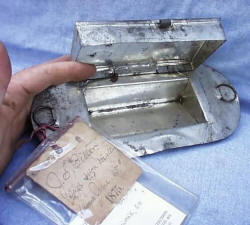 1875
Patent Model of Sad Iron Heater This
is an original Patent Model of a Sadiron Heater that we obtained at
auction a number of years ago. There are many different variations of
these devices available in full size, and they make for a very graphic
display. There were also stoves specifically made for this purpose
of heating sadirons
called laundry stoves that have built in ledges or holders to heat the
irons that the person ironing would set the iron on to reheat as she was
using another one that had been heating on a different ledge. The
idea with this style iron heater was that you would remove two burner lids
and their frame from your big old wood fired cookstove that you were also boiling
your water on, and insert a unit like this in their place into the top.
The lid feature would trap and retain
that much more heat, thus always assuring a heated iron, not to mention the
handle, for the busy lady
of the house. Ironing is almost a lost art, and I can easily imagine
that in the drudgery of that job the original concept of the women's
movement was born or conceptualized back in those good old
days.
1875
Patent Model of Sad Iron Heater This
is an original Patent Model of a Sadiron Heater that we obtained at
auction a number of years ago. There are many different variations of
these devices available in full size, and they make for a very graphic
display. There were also stoves specifically made for this purpose
of heating sadirons
called laundry stoves that have built in ledges or holders to heat the
irons that the person ironing would set the iron on to reheat as she was
using another one that had been heating on a different ledge. The
idea with this style iron heater was that you would remove two burner lids
and their frame from your big old wood fired cookstove that you were also boiling
your water on, and insert a unit like this in their place into the top.
The lid feature would trap and retain
that much more heat, thus always assuring a heated iron, not to mention the
handle, for the busy lady
of the house. Ironing is almost a lost art, and I can easily imagine
that in the drudgery of that job the original concept of the women's
movement was born or conceptualized back in those good old
days.
Good . . . . .$495.00 SOLD
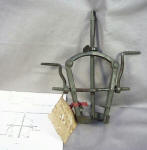 Patent
Model of Hub Borer This patent
model has its original tag and was designed to make the job of boring
wagon wheel hobs an easier task
Think of it as a beam bore meant to fit over a round wheel. I
have never seen the manufactured version, and this might well be one of
those that was never put into production.
Patent
Model of Hub Borer This patent
model has its original tag and was designed to make the job of boring
wagon wheel hobs an easier task
Think of it as a beam bore meant to fit over a round wheel. I
have never seen the manufactured version, and this might well be one of
those that was never put into production.Good . . . . .$495.00 SOLD
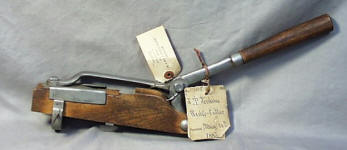 Patent
Model of Wedge Cutter From a time
when there was a need to have wedges. Primarily for tool handles I
suppose. It is operable and has its original tags.
Patent
Model of Wedge Cutter From a time
when there was a need to have wedges. Primarily for tool handles I
suppose. It is operable and has its original tags.
Good . . . . .$495.00 SOLD
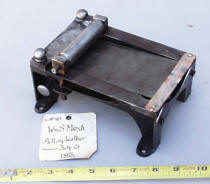 Patent
Model from 1865 of Leather Skiver or Splitter The nickel plated copper plaque or tag says that
the inventor, A Mr. Marsh was from Indianapolis Indiana, and that the name he
picked for his machine was Eureka. The idea here was that the thickness
of the material was set by moving the large flat table under the knife on a
sloped track to achieve different thicknesses. I have not pulled the papers
for this one and so do not know much else other than the fact that it must have
been a bitch going up against the crowd over in Newark with any new ideas about
how to do something with leather for if they did not already, in a few more
years they would have a near monopoly on the manufacture of such devices.
Different at the least, and surely rare as I certainly have not run into any
full size examples of this machine.
Patent
Model from 1865 of Leather Skiver or Splitter The nickel plated copper plaque or tag says that
the inventor, A Mr. Marsh was from Indianapolis Indiana, and that the name he
picked for his machine was Eureka. The idea here was that the thickness
of the material was set by moving the large flat table under the knife on a
sloped track to achieve different thicknesses. I have not pulled the papers
for this one and so do not know much else other than the fact that it must have
been a bitch going up against the crowd over in Newark with any new ideas about
how to do something with leather for if they did not already, in a few more
years they would have a near monopoly on the manufacture of such devices.
Different at the least, and surely rare as I certainly have not run into any
full size examples of this machine.
Good . . . . .$1295.00 SOLD
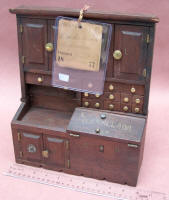 1877 Patent Model
Cupboard by W. H. Sallada of Monroe Iowa This patent model has its original tag.
It is a folksy representation of Mr. Sallada's better idea for a kitchen
cupboard. In reading his patent application it is evident that he
was a bit anal and controlling. His description calls for everything
in its place and a place for everything, and although he speculates that
somebody out there might want to do it different, in his opinion his way is
the best and most convenient. He did include a few good ideas in his
better idea for the cupboard. .
1877 Patent Model
Cupboard by W. H. Sallada of Monroe Iowa This patent model has its original tag.
It is a folksy representation of Mr. Sallada's better idea for a kitchen
cupboard. In reading his patent application it is evident that he
was a bit anal and controlling. His description calls for everything
in its place and a place for everything, and although he speculates that
somebody out there might want to do it different, in his opinion his way is
the best and most convenient. He did include a few good ideas in his
better idea for the cupboard. . This patent model is approx 10" wide x 12" tall. It is referred to as portable in the patent, and comes apart at the base / top. This model is a good match to the patent which can be viewed using Google Patents and a search for the number 191549. On the left is the sink area. Above that is a section with pegs or hooks. Below is a vented area. The patent calls for the drawers to be beveled so that they would be a tight fit. It further calls for some to be edged in rubber so as to preserve the aromas and freshness. He went all in on the folding table on the right. Its hinges are unique and allow it to fold out, down, up, or all the ways you could want. A great piece for a display in the early country kitchen.
This patent model cupboard will display nicely, and the condition is excellent!! Nice!!
Good +. . . . . .$895.00 SOLD!!
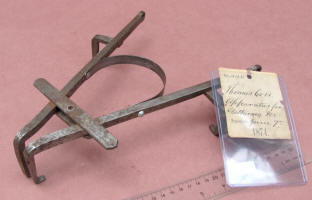 1874 Patent Model of
Apparatus for Gathering Ice
This patent model has its original tag and was issued on June 9th 1874 to
Thomas Cross of Pittston Maine.
This patent model is approx 10" long x 5"
or so wide at the widest point. The patent number is 151685 and is a good match to the patent
drawing which can be viewed
using Google Patents search with the number 151685.
1874 Patent Model of
Apparatus for Gathering Ice
This patent model has its original tag and was issued on June 9th 1874 to
Thomas Cross of Pittston Maine.
This patent model is approx 10" long x 5"
or so wide at the widest point. The patent number is 151685 and is a good match to the patent
drawing which can be viewed
using Google Patents search with the number 151685.The patent text is pretty simple and just mentions that ice is slippery and tends to want to get loose when you gather it. The patent states that the end and side hooks in play here will keep that from happening. It would probably make sense to a ice gatherer.
The condition is excellent!!
Excellent. . . . . .$295.00 SOLD!!
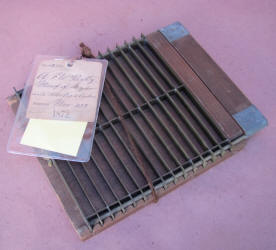 1872 Patent Model of Sugar
Cube / Block Maker by A. F. W. Partz of Oakland CA
This patent model has its original tag, the receiving tag, and a authenticity
tag form Cliff Peterson one of the original owners / buyers of the entire
collection of Patent Models after the government sold them.
Cliff Peterson bought the collection from O. Rundle Gilbert and set up shop
here in California selling some of them off to try and finance his idea for
the museum he envisioned for the collection. His plan worked no better
than the others who have attempted to preserve and / or market these
wonderful pieces, and after a number were sold off through his catalogs and
other sales efforts the collection again changed hands.
1872 Patent Model of Sugar
Cube / Block Maker by A. F. W. Partz of Oakland CA
This patent model has its original tag, the receiving tag, and a authenticity
tag form Cliff Peterson one of the original owners / buyers of the entire
collection of Patent Models after the government sold them.
Cliff Peterson bought the collection from O. Rundle Gilbert and set up shop
here in California selling some of them off to try and finance his idea for
the museum he envisioned for the collection. His plan worked no better
than the others who have attempted to preserve and / or market these
wonderful pieces, and after a number were sold off through his catalogs and
other sales efforts the collection again changed hands. This patent model by August Partz measures approx 8" x 10". It consist of two main pieces and is a good match to the patent which can be viewed using Google Patents and a search for the number 132921. The bottom wooden portion is the frame, and the upper portion with the rods and moveable strips the form. It is designed to have moist granular sugar poured over it once the user has it set up the form on the frame. The patent then calls for the sugar to be pressed into the form and allowed to dry for a couple of hours before removing the top frame. The strips are not fixed and when released from the frame move along the rods they are attached to so the removal of this frame is easier. You would then have strips or blocks of sugar which would them be cut or sawed into the right size cubes or blocks.
This would fit nicely in a display related to the candy industry or sugar which seems to be on the way to becoming a collectible if the PC / Medical crowd has its way. Nice!!
Very Good . . . . . .$395.00 SOLD!!
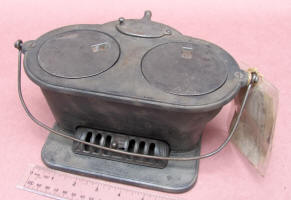 1878 Patent Model of Summer Stove / Furnace by Charles Truesdale of
Cincinnati Ohio
This patent model has its original tag. Mr. Truesdales idea was to use
the heat and flue of the larger inside range or Cookstove, and then take
this portion outside to actually cook the meal or keep things hot outside so
that the heat would not overheat the main house.
It looks like it would be a good idea and Mr. Truesdale went to great
lengths to describe what his invention was not, and how well it would work
for what it was. I imagine it could be used as an iron heater as well
and would be especially well suited for use in the summer when you did not
want to overheat the house.
1878 Patent Model of Summer Stove / Furnace by Charles Truesdale of
Cincinnati Ohio
This patent model has its original tag. Mr. Truesdales idea was to use
the heat and flue of the larger inside range or Cookstove, and then take
this portion outside to actually cook the meal or keep things hot outside so
that the heat would not overheat the main house.
It looks like it would be a good idea and Mr. Truesdale went to great
lengths to describe what his invention was not, and how well it would work
for what it was. I imagine it could be used as an iron heater as well
and would be especially well suited for use in the summer when you did not
want to overheat the house. This patent model is approx 10" wide x 6" tall. This model is a good match to the patent which can be viewed using Google Patents and a search for the number 216710
This patent model summer stove / furnace will display nicely, and the condition is excellent!! Nice!!
Excellent. . . . . .$595.00 SOLD!!
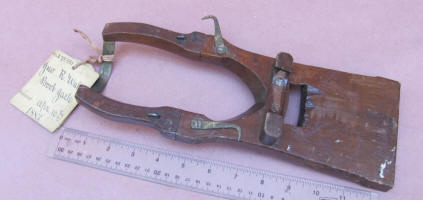 John
Walker of Richland MO. 1883 Patent Model
Boot Jack Mr. John R. Walker got the patent for his folding bootjack April
10th 1883.
The patent # is 275,551. This bootjack patent model is an exact duplicate of the one
pictured in the patent drawings. It is an interesting folding design
that he describes and claims is useful. Useful enough to have had a patent
granted,. A nice looking Patent Model that will fit well with any number
of collections.
John
Walker of Richland MO. 1883 Patent Model
Boot Jack Mr. John R. Walker got the patent for his folding bootjack April
10th 1883.
The patent # is 275,551. This bootjack patent model is an exact duplicate of the one
pictured in the patent drawings. It is an interesting folding design
that he describes and claims is useful. Useful enough to have had a patent
granted,. A nice looking Patent Model that will fit well with any number
of collections. Fine . . . . . .$595.00 SOLD!!
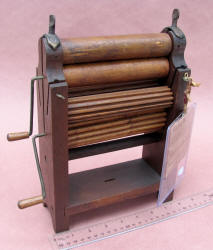 1873 Patent Model of Washing Machine / Wringer by A. M. Wilson of White
Ridge Michigan
This washing machine patent model has its original tag and a authenticity
tag from O. Rundle Gilbert who was one of the original owners / buyers of the entire
collection of Patent Models. Cliff Peterson later bought the entire collection from O. Rundle Gilbert and set up shop
here in California also selling some of them off to try and finance his idea for
the museum he envisioned for the collection. His plan worked no better
than the others who had previously attempted to preserve and / or market these
wonderful pieces of Americana and American History.
1873 Patent Model of Washing Machine / Wringer by A. M. Wilson of White
Ridge Michigan
This washing machine patent model has its original tag and a authenticity
tag from O. Rundle Gilbert who was one of the original owners / buyers of the entire
collection of Patent Models. Cliff Peterson later bought the entire collection from O. Rundle Gilbert and set up shop
here in California also selling some of them off to try and finance his idea for
the museum he envisioned for the collection. His plan worked no better
than the others who had previously attempted to preserve and / or market these
wonderful pieces of Americana and American History. This patent model is approx 8" wide x 12" tall. It major improvement over the standard roller / washer of its time was the utilization of 2 different roller systems and 2 cranks to drive them. One to wash and one to wring no doubt. Mr. Wilson also incorporated a complex design of springs and pins to make it work better. This model is a good match to the patent which can be viewed using Google Patents and a search for the number 142313.
This would fit nicely in a display related to laundry and wash day chores. The condition is excellent!! Nice!!
Excellent. . . . . .$595.00 SOLD!!
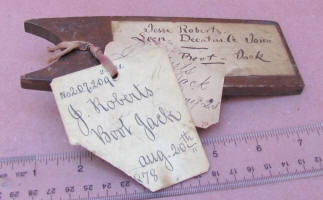 Jesse
Roberts 1878 Patent Model
Boot Jack Mr. Roberts got the patent for his bootjack August
20th 1878.
The patent # is 207,209. If the pics are correct, there are some pieces
missing from this model Given that they would be an integral part of the
operation I would say they are missing as opposed to Mr. Roberts changing the
idea halfway through, or later in production. It was done all the time,
but I see some holes here, and it just looks like it has a few missing parts.
It is a very simple design and looks good as it sits!
Jesse
Roberts 1878 Patent Model
Boot Jack Mr. Roberts got the patent for his bootjack August
20th 1878.
The patent # is 207,209. If the pics are correct, there are some pieces
missing from this model Given that they would be an integral part of the
operation I would say they are missing as opposed to Mr. Roberts changing the
idea halfway through, or later in production. It was done all the time,
but I see some holes here, and it just looks like it has a few missing parts.
It is a very simple design and looks good as it sits! Good + . . . . . .$175.00 SOLD!!
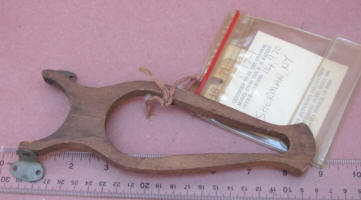 Milo Richardson Wall Mount Patent Model
Boot Jack Mr. Milo Richardson of Sherman NY was granted a patent for
his idea on May 16th 1871.
The patent # is 114,970. This bootjack was designed to mount on a wall and
swing down when needed. Basically the idea called for the boot jack to be
mounted to the base board so that when folded up it could go back beyond
vertical and lean against the wall and not fall forward. That was it, no
springs, cords, hold downs, or anything else. Just mount it proud of the
wall and let gravity do the work. A nice looking Patent Model that will fit well with any number
of collections.
Milo Richardson Wall Mount Patent Model
Boot Jack Mr. Milo Richardson of Sherman NY was granted a patent for
his idea on May 16th 1871.
The patent # is 114,970. This bootjack was designed to mount on a wall and
swing down when needed. Basically the idea called for the boot jack to be
mounted to the base board so that when folded up it could go back beyond
vertical and lean against the wall and not fall forward. That was it, no
springs, cords, hold downs, or anything else. Just mount it proud of the
wall and let gravity do the work. A nice looking Patent Model that will fit well with any number
of collections. Good +. . . . . .$125.00 SOLD!!
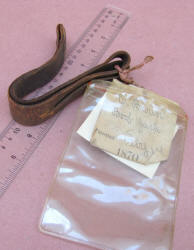 1870
Leather Boot Jack Patent Model
This bootjack was patented on February 1st
1870 by a Mr. Charles Brown of Charlottesville VA. This fellows idea
utilized the KISS approach to materials. Not sure the application or use
would quite meet that standard. The first step was to get it hooked up or
on the boot, and then you would use your other foot to also get into the mix,
and push off the boot. Great idea on paper, not so sure of how it would
work out in use, or how long it would last. What if it was muddy out?
Different!
1870
Leather Boot Jack Patent Model
This bootjack was patented on February 1st
1870 by a Mr. Charles Brown of Charlottesville VA. This fellows idea
utilized the KISS approach to materials. Not sure the application or use
would quite meet that standard. The first step was to get it hooked up or
on the boot, and then you would use your other foot to also get into the mix,
and push off the boot. Great idea on paper, not so sure of how it would
work out in use, or how long it would last. What if it was muddy out?
Different! Good . . . . . .$95.00 SOLD!!
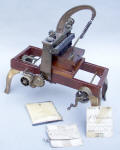 1879
Ironing Apparatus Patent
Model
James Crawford of Boston Mass held a few patents for large
commercial ironing machines. Not sure if any were ever
produced. Different!
1879
Ironing Apparatus Patent
Model
James Crawford of Boston Mass held a few patents for large
commercial ironing machines. Not sure if any were ever
produced. Different! Good . . . . . . SOLD!!
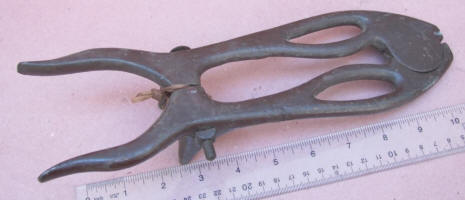 Patent
Model Boot Jack
A known and manufactured model. Different!
Patent
Model Boot Jack
A known and manufactured model. Different! Good . . . . . .$125.00 SOLD!!
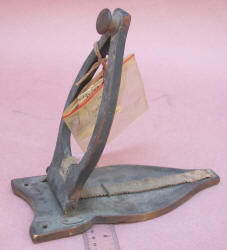 Patent
Model Boot Jack
A known and manufactured model. Different!
Patent
Model Boot Jack
A known and manufactured model. Different! Good . . . . . .$125.00 SOLD!!
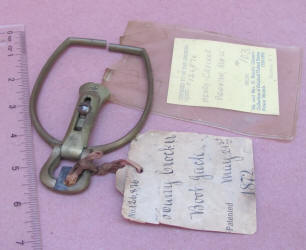 1872 Patent
Model Boot Jack
Different!
1872 Patent
Model Boot Jack
Different! Good . . . . . .$125.00 SOLD!!
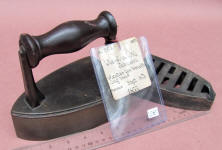 1855
Cleveland & Johnson Patent Model for Sad Iron Heater It
appears the patent is for the slug with numerous holes in it that
fits inside the iron to help with heat flow. This is the only
example I have ever seen and do not think it made it into widespread
production. Super condition.
1855
Cleveland & Johnson Patent Model for Sad Iron Heater It
appears the patent is for the slug with numerous holes in it that
fits inside the iron to help with heat flow. This is the only
example I have ever seen and do not think it made it into widespread
production. Super condition.
Good +. . . . .$3495.00 SOLD
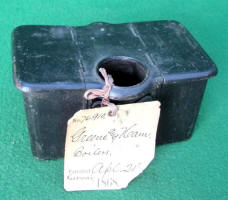 1868
Patent Model of Boiler / Water Tank
This patent model has its original tag. It looks like the water tank form a
Charter Oak 503 salesman sample stove meaning that it would hook onto or be
a part of a wood fired stove and would produce hot water at the same time.
1868
Patent Model of Boiler / Water Tank
This patent model has its original tag. It looks like the water tank form a
Charter Oak 503 salesman sample stove meaning that it would hook onto or be
a part of a wood fired stove and would produce hot water at the same time.
This patent model is approx 10" wide x 6" tall. This model is a good match to the patent which can be viewed using Google Patent Search
This patent model water boiler / storage tank will display nicely, and the condition is excellent!! Nice!!
Excellent. . . . . .$325.00 SOLD!
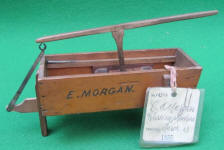 1855
Washing Machine Patent Model
This washing machine patent model is a push / pull / rubber / scrubber design
and has its original tag. It originates from the Glissman Iron
Collection who were buying models from Cliff Peterson who lived nearby them
back in the 70's / 80's.
1855
Washing Machine Patent Model
This washing machine patent model is a push / pull / rubber / scrubber design
and has its original tag. It originates from the Glissman Iron
Collection who were buying models from Cliff Peterson who lived nearby them
back in the 70's / 80's. The patent was issued on March 13th 1855 to E. Morgan. This patent model is approx 6" tall x 11" long and in very nice condition. The patent number is 12518 and this model is a pretty good match to the patent drawing which can be viewed using Google Patents search with the number 12518.
This Patent Model Washer is an interesting design and was cutting edge technology for the time. The inventor put a lot of thought into the workings and features. A lot of later washers use the same basic ideas and action. Basically it takes the idea of a standard washboard, enlarges it, lays it down in a tub, and then mechanizes it. It is basically a wash tub with one built in washboard that can be raised or lowered inside the tub, and a second smaller washboard / rubber with a handle that you use to scrub the dirt away. The condition is excellent!! An nice one!!
Excellent. . . . . .$675.00 SOLD!
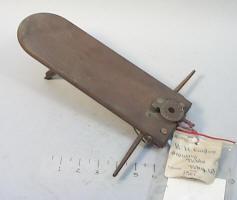 1877
Patent Model Ironing Board This
was designed to clamp onto an existing table or cabinet. It
had little swing out drying racks, and a built in trivet. What
would one think of next? Super condition.
1877
Patent Model Ironing Board This
was designed to clamp onto an existing table or cabinet. It
had little swing out drying racks, and a built in trivet. What
would one think of next? Super condition.
Good +. . . . .$175.00 SOLD
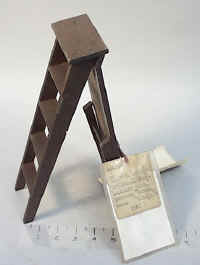 1880
Patent Model Ironing Board / Ladder There
were numerous patent for this combination of an ironing board and
ladder. From a time when both were a necessity and space was
at a premium. Super condition.
1880
Patent Model Ironing Board / Ladder There
were numerous patent for this combination of an ironing board and
ladder. From a time when both were a necessity and space was
at a premium. Super condition.
Good +. . . . .$325.00 SOLD
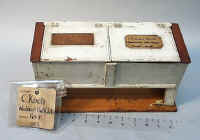 1879
Patent Model Combination Washing Machine / Bath Tub This
idea was presented by a fellow named Kock from NY. The patent
request claims it was to be used in tenements where there was
limited space and a need for both clothes cleanliness and personal
hygiene needs.
1879
Patent Model Combination Washing Machine / Bath Tub This
idea was presented by a fellow named Kock from NY. The patent
request claims it was to be used in tenements where there was
limited space and a need for both clothes cleanliness and personal
hygiene needs.
Good +. . . . .$450.00 SOLD
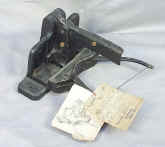 Patent Model of Tire Upsetter I
believe this was for wooden wheels to help in removing the wire rim,
not anything to do with rubber tires as we know them.
Patent Model of Tire Upsetter I
believe this was for wooden wheels to help in removing the wire rim,
not anything to do with rubber tires as we know them. Good . . . . .$295.00 SOLD
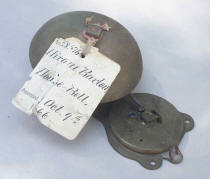 October
9th 1866 Patent Model House Bell This
is an interesting patent model.
October
9th 1866 Patent Model House Bell This
is an interesting patent model.
Good . . . . . SOLD
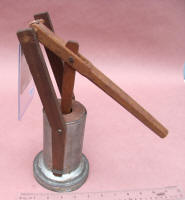 1879
Washing Machine Patent Model
This washing machine patent model is a lever operated plunger type and has its original tag.
The patent was issued on January 7th 9th 1879 to
Robert Ward and Robert Rogers of Arkansas. This patent model is
approx 10" tall x 4"
or so wide at the widest point. The patent number is 211198 and this model is a good match to the patent
drawing which can be viewed
using Google Patents search with the number 211198.
1879
Washing Machine Patent Model
This washing machine patent model is a lever operated plunger type and has its original tag.
The patent was issued on January 7th 9th 1879 to
Robert Ward and Robert Rogers of Arkansas. This patent model is
approx 10" tall x 4"
or so wide at the widest point. The patent number is 211198 and this model is a good match to the patent
drawing which can be viewed
using Google Patents search with the number 211198.The patent text claims that the clothes are washed when the suction created by pumping the handle up and down forces the water through the clothes and delivers a superior result compared to those other washers that rely upon rubbing or other agitators which wear out the clothes to boot. Although I have seen hundreds of different style plunger type washers, with all sorts of different gizmos to help with the action down there, I have never seen a full size version of this one. Different!!
The condition is excellent!!
Excellent. . . . . . $395.00 SOLD!!
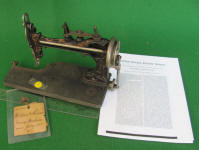 McLean & Bennor 1873 Patent Model Sewing Machine The
patent for this unusual machine was granted on January 21 1873. The
patent number is 135,000. It comes up with a Google search. I
have never seen or had a sewing machine produced by this partnership. The
partnership between McLean & Bennor lasted just 3 years from 1873 -
1876.
McLean & Bennor 1873 Patent Model Sewing Machine The
patent for this unusual machine was granted on January 21 1873. The
patent number is 135,000. It comes up with a Google search. I
have never seen or had a sewing machine produced by this partnership. The
partnership between McLean & Bennor lasted just 3 years from 1873 -
1876.This sewing machine is similar looking to a McLean & Hopper sewing machine who was also McLean's partner during the same period. What the relationship between the three was is unknown. There is info to be found on the internet and at the Smithsonian site about them and the parent company The Centennial Sewing Machine Co. The last listing for that company was also 1876.
The patent mentions the machine bed being "broken away" to better show the working parts. That has been done. Problem is some of those parts below the bed are missing. Most notably the bobbin case and hook assembly which is described in the patent. Different and nice!!
Good . . . . . . . $1250.00 SOLD!!
 1873
Patent Model of Wick Raiser for Oil Lamp Abel
Combs was granted a patent for his wick raising idea for oil lamps on
February 18th 1873 .
The patent number is 136034. It is viewable on Google and is a close
match.
He had at least one other patent granted in 1885 related to lamps and wicks as well.
He resided in Philadelphia PA.
1873
Patent Model of Wick Raiser for Oil Lamp Abel
Combs was granted a patent for his wick raising idea for oil lamps on
February 18th 1873 .
The patent number is 136034. It is viewable on Google and is a close
match.
He had at least one other patent granted in 1885 related to lamps and wicks as well.
He resided in Philadelphia PA.The patent describes the means by which the wick is raised. Not being a lamp person it is hard for me to describe and looking at the top wick area I can not tell exactly how it would work. The model looks great though and is a complete lamp on a nice milk glass base that is chip or damage free. It has a great looking circular brass body that is dent or damage free. It has its original tag and ribbon. The overall condition is nice. An interesting & unusual display piece!!
Very Good . . . . . . $995.00 SOLD!!
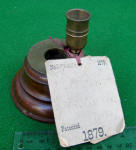 1879
Benson Patent Model of Inkstand / Inkwell The
patent was granted on July 8th 1879 to Henry Benson of NY.
The patent number is 217256. It is viewable on Google with a bit of
work. The idea
here was that the user would fill the upper brass container with dried
material, the coloring agent used to create ink, and after pouring water or
other suitable material into the top hopper / container, ink would be
created and flow down into
the lower bowl to be used. It is interesting to note that the patent
was assigned to Joseph Reckendorfer who is famous for being the first to
develop a pencil w/ eraser on it.
1879
Benson Patent Model of Inkstand / Inkwell The
patent was granted on July 8th 1879 to Henry Benson of NY.
The patent number is 217256. It is viewable on Google with a bit of
work. The idea
here was that the user would fill the upper brass container with dried
material, the coloring agent used to create ink, and after pouring water or
other suitable material into the top hopper / container, ink would be
created and flow down into
the lower bowl to be used. It is interesting to note that the patent
was assigned to Joseph Reckendorfer who is famous for being the first to
develop a pencil w/ eraser on it. This patent model is nicely constructed with finished wood base, and brass cup and plate on the top.. It has its original tag that is quite faded. The overall condition is nice. An interesting & unusual display piece!!
Very Good . . . . . . $395.00 SOLD!!
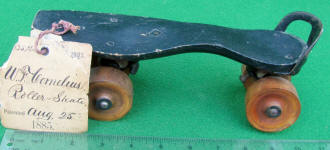 1885 Patent Model of
Roller Skate by W. F. Cornelius The
patent for this roller skate was granted on August 25 1885.
The patent number is 325161. It is viewable on Google and is a close
match. Wilber Cornelius held more than one patent for roller skates
and had a different one issued or granted just one week prior to this one.
He had at least one other as well.
He resided in Muncie Indiana.
1885 Patent Model of
Roller Skate by W. F. Cornelius The
patent for this roller skate was granted on August 25 1885.
The patent number is 325161. It is viewable on Google and is a close
match. Wilber Cornelius held more than one patent for roller skates
and had a different one issued or granted just one week prior to this one.
He had at least one other as well.
He resided in Muncie Indiana.The patent describes the wheels, axels, and how they are operable, adjustable, and flexible. His ideas were cutting edge and the design looks similar to those on modern day roller skates and skateboards. In reading the patent one sees that later designers often referred to his patents when seeking their own.
This patent model is nicely constructed with wood platform, and hardwood wheels attached to multi piece adjustable steel brackets. It has its original tags. The overall condition is nice. An interesting & unusual display piece!!
Very Good . . . . . . $495.00 SOLD!!
 1877
Sack Packer Patent Model by Herman Barnard of Moline Illinois The
patent was granted on November 27th 1877.
The patent number is 197590. It is viewable on Google. Herman
Barnard hailed from Moline Illinois and was a founding partner of Barnard &
Leas Mfg. Co. who he assigned this patent to. Barnard & Leas Mfg. Co. was a
well known manufacturer of farm and corn related tools and products including things
like corn shellers and the like. There is a nice Bio on Barnard and the company
online at
an Illinois
ancestry site.
1877
Sack Packer Patent Model by Herman Barnard of Moline Illinois The
patent was granted on November 27th 1877.
The patent number is 197590. It is viewable on Google. Herman
Barnard hailed from Moline Illinois and was a founding partner of Barnard &
Leas Mfg. Co. who he assigned this patent to. Barnard & Leas Mfg. Co. was a
well known manufacturer of farm and corn related tools and products including things
like corn shellers and the like. There is a nice Bio on Barnard and the company
online at
an Illinois
ancestry site. The patent model is very mechanical and nicely constructed. It stands just about 12" tall. The overall condition is nice noting the chains to lift the upper hopper are disconnected or missing. Most everything else seems to be right. Interesting & unusual!!
Very Good . . . . . . $700.00 SOLD!!
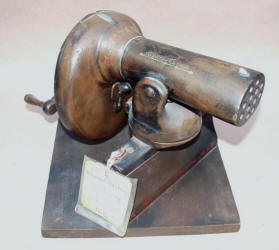 1870
Patent Model of Revolving Cannon This 1870 Patent Model of Revolving Cannon is a very unique and early
ordinance related patent model. This
is not a toy, it is the actual model presented to the US patent Office for a
patent in 1870. The patent was granted on December 20th 1870. This Patent Model of
a Revolving Cannon is a unique and early
ordinance related patent model. Patent models of ordinance or
firearms are very rare and seldom come on the market. The Patent number is
110,194 and the inventors name was Eduard Brehm of Jersey City NJ. A
Google search brings it up, and it is a good match.
1870
Patent Model of Revolving Cannon This 1870 Patent Model of Revolving Cannon is a very unique and early
ordinance related patent model. This
is not a toy, it is the actual model presented to the US patent Office for a
patent in 1870. The patent was granted on December 20th 1870. This Patent Model of
a Revolving Cannon is a unique and early
ordinance related patent model. Patent models of ordinance or
firearms are very rare and seldom come on the market. The Patent number is
110,194 and the inventors name was Eduard Brehm of Jersey City NJ. A
Google search brings it up, and it is a good match.The patentee calls his invention a revolving cannon as the term machine gun or Gatling gun were not yet in common use. This patent model is made almost entirely of wood. Note the decoration and title "Revolving Cannon" on the wooden barrel. Also note the small worm drives Brehm designed to adjust the elevation and to move the gun or cannon left to right. The firing operation and type of ammunition is described in detail in the patent papers but the model does not open too inspect those mechanisms or their design. When the rear crank is turned it makes a clacking sound like a noise maker. A unique piece of Americana that will display well in a number of themed collections.
Very Good . . . . . . $2050.00 SOLD!!
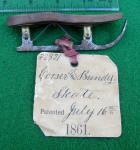 Corser
& Bundy 1861 Patent Model of Ice Skate The
patent was granted on July 16th 1861.
The patent number is 32821. It is viewable on Google. Corser &
Bundy hailed from Clappville Mass.
Corser
& Bundy 1861 Patent Model of Ice Skate The
patent was granted on July 16th 1861.
The patent number is 32821. It is viewable on Google. Corser &
Bundy hailed from Clappville Mass.This small patent model is nicely constructed. It has its original tag. The idea for the patent is that the runners are spring loaded and lockable in either a fixed position, or the spring loaded mode. The idea being that it would be changed as the smoothness of the ice changed. The patent reads that the inventors understand that spring loaded runners are not a new idea, but that they way they have set it up here is. That was enough to be granted a patent. The overall condition is nice. An interesting & unusual display piece!!
Very Good . . . . . . $495.00 SOLD!!
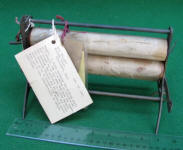 1865
Patent Model of Mangle William Price of
Cincinnati Ohio was granted a patent for this clothes mangle / washer on
January 17th 1865. This model came from the Mr. & Mrs. O. Rundell
Gilbert collection and has those tags as well as the original Patent Office
tag. The fabric on the rollers is beginning to come loose.
The idea revolved around the folding design making it easier to operate and
care for both the clothes and the machine when not in use. A nice
display piece that dates from the Civil War era of American History.
1865
Patent Model of Mangle William Price of
Cincinnati Ohio was granted a patent for this clothes mangle / washer on
January 17th 1865. This model came from the Mr. & Mrs. O. Rundell
Gilbert collection and has those tags as well as the original Patent Office
tag. The fabric on the rollers is beginning to come loose.
The idea revolved around the folding design making it easier to operate and
care for both the clothes and the machine when not in use. A nice
display piece that dates from the Civil War era of American History.
Good . . . . . . $150.00 SOLD!!
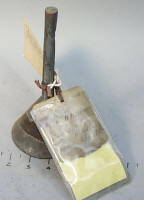 Patent
Model Plunger Washer
Patent
Model Plunger Washer
Good . . . . . $195.00 SOLD
1848 Patent Model of Cook Stove by D. Buck I'm not sure if this super and interesting patent model is by anyone having anything to do with the current line of Buck Stoves, but this fellow sure was proud of his name, and embellished and decorated every available panel with scenes of a large deer in the forest. These are not just painted on the surface, they are 3-dimensional. I never pulled the patent, but he has vents and chambers and even a cold air intake on the bottom. In addition to the original tag and red ribbon, the top of the stove is clearly marked "D. Buck's Patent". Overall it measures just under 12" deep by 8" wide and 6 1/2" tall. It is made out of tinned steel with the exterior painted black. The hinged doors and vents are present and operable, and as with many patent models, Mr. Buck didn't bother with the top plates to give you a better and unobstructed view of the inner workings. This is a great example of a one-of-a-kind patent model and a super piece of Americana to boot. It has the added plus of name recognition in today's world, and the artistic endeavors by Mr. Buck are an added bonus rarely seen on such models.
Good . . . . . SOLD
1876 Patent Model of Burglar Door Alarm and Locking Mechanism Here is a super one of a kind original Patent Model of a Burglar Alarm & Door Lock Mechanism dating from 1876 which is just incredible. It measures approx. 12 " tall by 10" wide and is made of a stained wood to resemble a walnut or mahogany. Its provenance is that it is from the O. Rundle Gilbert Collection, and was sold at the Christies Auction a few years ago. It has its original patent office receiving tag and red ribbon, along with a green one from Mr. Gilbert's inventory. There are remnants of another tag nailed on the model, but most of this one is gone. The idea from looking at and playing with it a bit is that once you had set it, if someone were to later jiggle or try and force the handle in either direction the bell would sound, and at the same time lock the door. It would do this if the handle was turned in either direction. The dome for the bell is not present, but that is proper as it would not be needed and would interfere with viewing of the operation of the model. I have seen a couple of really great patent models passed over because the perspective buyer did not feel it was complete, when in actuality it was made that way and submitted like that, to better demonstrate the model. This is an interesting and desirable piece of Early American History, and as I said in the beginning it is a one of a kind, so when this one is gone, there will not be another.
Good . . . . . SOLD
Sept. 3 1867 Patent Model of Oil Dispenser / Can This is an interesting patent model of the type of Oil Dispenser / Can that you occasionally see full-size at old time auctions, or in petroliana museums or collections. You will never have the opportunity to find another one this size with its original patent tags as this is the only one there is. These Patent Models are far rarer than they may seem, and when the small supply that are presently around are gone, there will be no more. These wonderful pieces of Americana are one-of-a-kinds and each one has a story to tell, and should have a place high up on the shelf in your collection or museum. This super piece measures just under 12" tall by about 8" across. It is in super condition, noting the one small dent in the of the name G. H. Hatch, who was from Pomeroy, Ohio. The pump was made to work, and is complete with stop valves, gaskets, and the rest. Oftentimes you see a model of a piece of which you have never seen the actual full-size item, but that is not the case here, and hopefully Mr. Hatch made a lot of money with his idea.
Good . . . . .$995.00 SOLD
BACK to Patent Models / Salesman Samples
This is just a sample of the many
antique Patent Models & Salesman Samples we have sold.
Click link to see other
Sales Archive Pages on this Site.
We Buy Quality Antiques Similar to those
shown
Contact Us at
AntiqBuyer@gmail.com
Our current offering of Antiques for sale are at our sister Website Patented-Antiques.com.
This website is Copyrighted
Larry & Carole Meeker